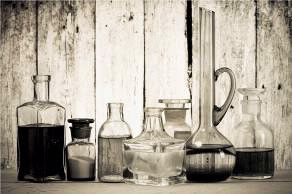EMBARGOED FOR RELEASE | April 07, 2013
First tests of old patent medicine remedies from a museum collection
Note to journalists: Please report that this research was presented at a meeting of the American Chemical Society.
NEW ORLEANS, April 7, 2013 — What was in Dr. F. G. Johnson’s French Female Pills and other scientifically untested elixirs, nostrums and other quack cures that were the only medicines available to sick people during the 18th, 19th and early 20th centuries?
Scientists provided a glimpse today based on an analysis of a museum collection of patent medicines used in turn-of-the-century America. It was part of the 245th National Meeting & Exposition of the American Chemical Society, the world’s largest scientific society, which is being held here this week.
Mark Benvenuto, Ph.D., who headed the study, explained that hundreds of untested products were sold in stores, by mail order or in traveling medicine shows during the patent medicine era. The products were called “patent medicines” not because they had been granted a government patent, but from an unrelated term that originated in 17th century England.
Media Contact
During April 5-10 the contacts can be reached at 504-670-4707.
Michael Bernstein
202-872-6042
m_bernstein@acs.org
Michael Woods
202-872-6293
m_woods@acs.org
“This was an era long before the controlled clinical trials and federal regulations that ensure the safety and effectiveness of the medicines we take today,” Benvenuto explained. “Many patent medicines had dangerous ingredients, not just potentially toxic substances like arsenic, mercury and lead, but cocaine, heroin and high concentrations of alcohol.”
The samples came from the collection of the Henry Ford Museum, in Dearborn, Mich. The museum houses artifacts celebrating American inventors of various items, including planes, cars, trains, machines, furniture and more. The 50 patent medicines in the analysis were among hundreds in the museum’s Health Aids collection. The results of Benvenuto’s study are on display at the museum.
Undergraduate students working under Benvenuto’s supervision performed the bulk of the research. Andrew Diefenbach, a senior and mechanical engineering major at the university, presented the group’s research in a talk here today. He got involved in the project as a freshman in Benvenuto’s general chemistry course. “I’m interested to see what other comments people have, and what kind of things they may have thought of that we haven’t thought of so far that we can use to further the research,” Diefenbach said.
Some of the ingredients in the samples of old patent medicines, including calcium and zinc, actually could have been healthy and are mainstays in modern dietary supplements, said Benvenuto. He is with the University of Detroit Mercy. But others were clearly dangerous. Analysis of Dr. F. G. Johnson’s French Female Pills, for instance, revealed iron, calcium and zinc. But the nostrum also contained lead, which is potentially toxic. Others contained mercury, another potentially toxic heavy metal, and arsenic.
Benvenuto explained that the presence of heavy metals may have been due to contamination. On the other hand, there actually was a rationale for including some of them. Arsenic and mercury were mainstays for treatment of syphilis, for instance.
To automatically receive news releases from the American Chemical Society contact newsroom@acs.org.
###

20th centuries had dangerous ingredients.

